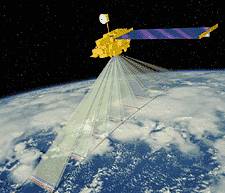 |
MISR Browse Tool |

|

|
The Multi-angle Imaging SpectroRadiometer (MISR) views the Earth like no other instrument. It obtains calibrated images in four spectral bands at each of nine angles, providing new information for scientists studying the Earth.
The MISR instrument orbits the earth about 15 times each day recording data during the daylight portion of the orbit. The orbit number indicates the number of revolutions or orbits since launch. There are 233 distinct orbits which are repeated every 16 days. Each of these 16 days is referred to as a Data Day. The 233 repeating orbits are called paths. Each path is divided into 180 blocks. Since the paths overlap, near global coverage is obtained in 9 days.
The nine MISR cameras are pointed at fixed angles, one viewing vertically downward (nadir or An) and four each viewing the forward and aftward directions along the line of the orbit. The four cameras viewing forward are designated Af, Bf, Cf, and Df (the Af camera being closest to the vertical,) while those viewing aftward are designated Aa, Ba, Ca, and Da.
The MISR Browse Tool allows easy access to images from the MISR instrument. The browse images are ellipsoid color images for each camera and are available at two different resolutions. The default resolution is 4.4km. The image is enlarged to a 2.2km resolution by selecting "Full Size" on the controls menu in the upper left corner of the Browse Tool. The MISR red, green and blue bands are used to create the color image, which has been intentionally clipped and gamma-stretched to make cloud, ocean and land features visible.
MISR was built for NASA by the Jet Propulsion Laboratory in Pasadena, California. For more information on MISR and its mission, check out the MISR Home Page. It is part of the Earth Observing System of NASA's Earth Science Enterprise. MISR was launched into a polar orbit around Earth on 18 December 1999 onboard the Terra spacecraft.